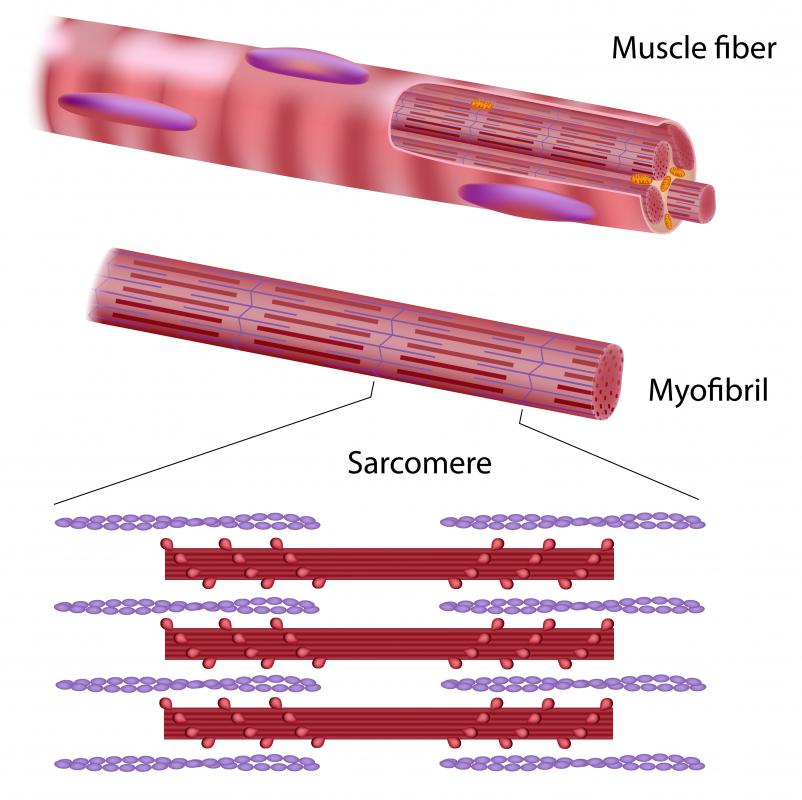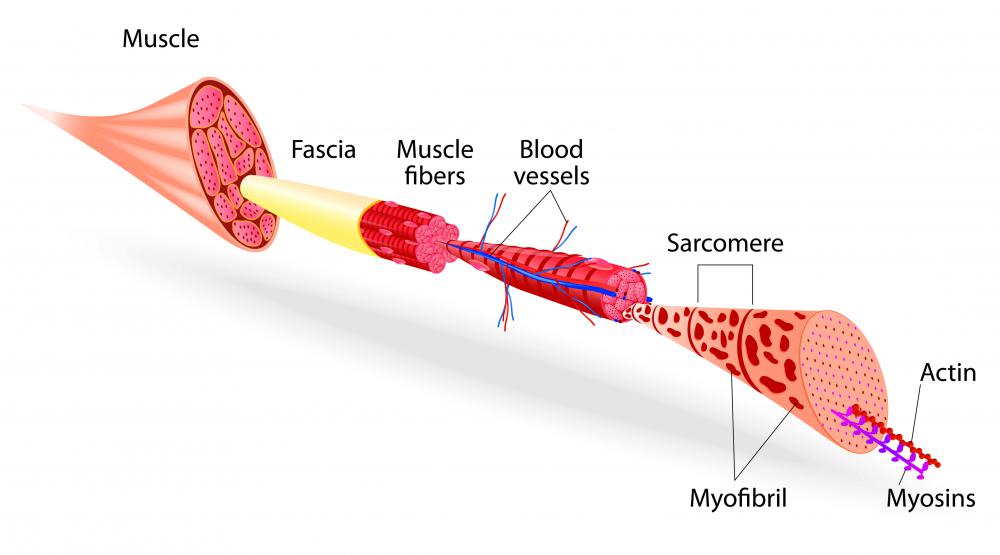At TheHealthBoard, we're committed to delivering accurate, trustworthy information. Our expert-authored content is rigorously fact-checked and sourced from credible authorities. Discover how we uphold the highest standards in providing you with reliable knowledge.
What Is a Muscle Cell?
A muscle cell is a special kind of cell that makes up an organism's muscle tissues. The muscles allow independent movement and regulate biological functions such as digestion and heartbeat. These cells are further specialized into distinct types based on their location and functions. All of them control movement by contracting; while much of this activity is involuntary, the muscles that direct the skeletal system can be consciously controlled. These muscles can be trained to carry out highly precise movements and strengthened through exercise.
Cellular Biology

All organisms are composed of structures called cells, many of which are microscopic. In complex creatures such as humans, these cells number in the trillions, and become highly specialized in early development. Nerve cells, for example, make up the brain and nervous system and can reach lengths of 3 feet (1 m), but are incapable of independent movement. Muscle cells, by contrast, have structures that allow for a wide range of motion, from the measured routines of a gymnast to the constant beating of the heart.
Types of Muscle Tissue

The medical term for a muscle cell is a myocete. During the embryonic, or pre-birth, stage of development, cellular bodies called myoblasts mature and develop into the various kinds of myocetes. In humans and higher animals, there are three kinds of muscle cells, corresponding to the major categories of muscle: skeletal, cardiac, and smooth.
Skeletal muscles, also called striated muscles, are governed by voluntary commands, and allow a broad range of body movements. Cardiac muscles keep the heart beating, and are capable of uninterrupted activity without fatigue. Smooth muscles, like cardiac muscles, are subject to involuntary commands, and are regulated by the brainstem located at the base of the skull. These smooth muscles ensure that the internal organs function normally, such as the muscular contractions that move food through the digestive tract.

The three kinds of muscle tissue can be identified easily by their organizing structures, which are particularly visible under a microscope. Skeletal muscle tissue, the most common kind of muscle tissue in humans and other large animals, has striations, or grooves, that mark out each individual muscle cell. These cells, sometimes called muscle fibers, extend the length of the muscle. This is necessary for the cells to perform their function efficiently.

Smooth muscle tissue, as the name implies, has a uniform appearance, similar to that of non-muscular tissue. The cells do not need to be as elongated as skeletal muscle fibers, because the motion created by these muscles is more gradual and requires less energy.
Cardiac muscle tissue has striations like that of skeletal muscles, but the cells are smaller, like those of smooth muscles. They also have a distinctive branched structure that is better suited to the task of constantly pumping blood through the heart. Otherwise, the two types of muscle are very similar.
Cell Structure

Muscle cells are made up of myofibrils, organic cable-like structures composed of essential proteins. Within the myofibrils are bundles of these proteins, arranged into thick and thin filaments within repeating sections known as sarcomeres. Responding to voluntary or involuntary nerve commands, these proteins slide past each other, causing the muscle cells to contract or relax and create movement. These mechanisms for motion are called actomyosin motors, referring to the proteins that compose them, actin and myosin.

All cells have a central organizing body called the nucleus. While most cells have just one, skeletal myocetes have several nuclei scattered along the length of the cell. This allows information and nutrients to be delivered more quickly throughout the cell. Cardiac and smooth muscle cells have the traditional single nucleus, although in smooth cells the nucleus is elongated, like the cells themselves.

Muscle cells can draw energy from proteins, fat, or glucose, a form of sugar created in the digestive process. Although most nutrients are distributed to muscles through the bloodstream, each muscle cell also stores a small amount of fat and glucose within itself as a ready source of energy, so the muscle can be used at any time.
Muscle Cells and Exercise
Certain types of exercise can cause muscle tissue to expand. The muscle cells themselves within the affected muscle will actually enlarge, as the increasing demand on the muscle caused by weight training, for example, triggers the release of biological growth hormones. The medical term for this type of muscle growth is called hypertrophy. This is different from hyperplasia, which is an increase in the actual number of muscle cells.
Hypertrophy can be stimulated by hormones like testosterone, which is why teenage boys may experience startling muscular changes, such as growth spurts, around puberty. This increase in muscle mass can also be stimulated artificially by injections of performance-enhancing drugs and hormones. Hormone injection can also have unforeseen health effects, including causing muscle hyperplasia. The abuse of these chemicals has become a legal and ethical issue in professional athletics.
Health experts recommend regular exercise to strengthen muscle cells for everyone, not just athletes. In addition to maintaining muscle strength, exercise has well-documented positive effects throughout the body, including improving a person's mood. Strenuous exercise sometimes causes muscle soreness, which is often caused by minute damage to muscle cells as a result of unaccustomed exertion. Regular exercise of the muscle typically reduces this soreness, as the tissue quickly adapts to new demands.
Frequently Asked Questions
What is the function of a muscle cell?
Muscle cells play a vital role in producing force and movement. These cells are responsible for the contraction and relaxation of muscles by containing contractile proteins such as actin and myosin. Muscle cells are arranged in layers of muscle fibers, allowing them to respond to nervous system stimulation and generate force.
What is the makeup of a muscle cell?
A muscle cell comprises a plasma membrane, various organelles, and molecules. The plasma membrane acts as a protective barrier and regulates the exchange of substances between the cell and its surroundings. Organelles such as mitochondria generate energy for the cell, while the endoplasmic reticulum synthesizes proteins. Muscle cells also contain other organelles like lysosomes, ribosomes, and Golgi bodies.
How do muscle cells contract?
Muscle cells contract when actin and myosin filaments slide past each other, a process that is triggered by a nervous system signal. Cross-bridges connect actin and myosin filaments, and when calcium ions bind to the myosin filaments, the myosin heads attach to actin filaments, generating mechanical force that contracts the muscle.
How do muscle cells relax?
Muscle cells relax when calcium ions unbind from myosin filaments, accomplished by the enzyme ATPase breaking down ATP molecules to release calcium ions. This breaks the cross-bridges between actin and myosin filaments, allowing them to slide past each other and relax the muscle.
How do muscle cells generate energy?
Muscle cells produce energy through cellular respiration, which breaks down glucose molecules to produce ATP molecules that power muscle cells. The mitochondria produce ATP molecules used for muscle contraction and relaxation.
AS FEATURED ON:
AS FEATURED ON:

















Discussion Comments
What do they look like?
Are fats or cholesterol embedded around the muscle? How can it be sheared off?
What would happen if the cardiac muscle was taken away?
I would like to know what a muscle cell looks like and the size and shape please? I can't find it anywhere and I'm doing a project on it.
Muscle cells themselves have an intricate anatomy which enables them to function well on a very small level. The exchange and usage of various chemicals in their system enables them to send and receive signals which govern the overall function of the entire group of cells. These cells receive data which tells them how to behave and function differently from person to person. For instance, some people are genetically endowed with larger muscles than others due to DNA encoding sent to muscle cells.
An easy way to look at muscle cells is that they behave like little batteries, with voltages (membrane potentials) in the millivolt range. This enables cells to generate tiny little electrical currents which makes it possible for the muscle cell to twitch, or contract and pump blood.
Heart muscle cells in an adult normally don’t divide. They just increase in size.
Muscles can account for around 40% of your body weight. The longest muscle in the body has muscle cells that are over a foot long. Muscles can only pull. They cannot push.
Post your comments